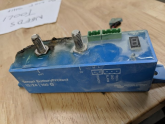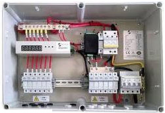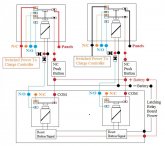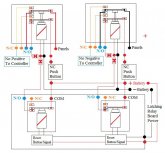@JeepHammer the BP is neither diode based nor latching, so you simply can't compare it to other devices. Can you easily replace one BP with three or four other non-proprietary components? Absolutely, and I strongly encourage you in particular to do that.
I don't understand why you argue with me when all you have to do is read the manual to verify what I say. I'm done arguing with you about it, though... If you'd like to hook it up incorrectly, fry it, and potentially set your system on fire, you go buddy.
Yet again, I'm only here because you gave other people potentially catastrophic advice. You obviously know a great deal about other components, and that's great, so either learn how Victron components are to be used, or stick to the components that you understand - either way, however, you need to stop assuring people that they can do things with Victron components that they absolutely cannot and might in fact cause critical system damage if not an outright fire.
Please DO stop arguing...
There are at least three conversations going on here, please try to keep up...
As for the insults about "Catastrophically Bad Advise", you missed the entire point it was a discussion, kicking around some idea, and NO ONE BUT YOU TOLD ANYONE WHAT THEY 'HAD' TO DO...
It seems to me you can't grasp the idea of people kicking around idea and building off them.
If *I* screw something up, it won't be the first time, and probably won't be the last, that's my choice to try something different.
I'm NOT here to hawk products or give anyone a hard time.
As for relays, diodes and whatever, THIS IS A DIY FORUM, not a "BUY MY STUFF" forum.
Relays, Diodes, Switches were around a LONG time before you or Victron, and they still work just fine, particularly for teaching DIY types how this stuff works, learning to build circuits.
*IF* the conversation rolls around to using MOSFETs both forwards and backwards, then I'll simply diagram and picture that out also.
I'm aware that as the DIY types figure this out, it will roll around to that eventually, everything will never go entirely solid state,
And while the electro-mechanical parts are cheap, they have draw backs, but they still work just fine.
I have to assume that $25 on eBay to do what you can't decide if ANY of Victron can do or not,
*MAYBE* with proprietary support hardware...
I can POSITIVELY do with $20 Power Relay & $5 Latching Relay, Positive Disconnect charger from battery via BMS signal.
What Victron can't do at all, Disconnect solar panels, and keep them disconnected from charge controller.
That's a latching relay for trigger, stepper relay to keep 80A relay locked out via $2 in diodes, So another $5 on eBay.
And I can put it all on DIN rails, Cheap DIN boxes are all over ebay if you don't want to screw the rail to the wall (what a lot of DIY types do).
-----------------------------------------------
While I'm FORCED to continue this subject, I've NEVER had a disconnect/relay look like that.
 All the way up to 300 & 400 Amp contactors around here, and Victron tops out at 220 Amps...
All the way up to 300 & 400 Amp contactors around here, and Victron tops out at 220 Amps...
eBay and every golf cart supply sells 400 Amp Double Pole, Double Throw Industrial Contactors every day.
BOTH CIRCUITS in a 400 Amp Double Pole contactor will handle 800 Amps...
The Normally Closed does just fine in the 'Normal' position, while the "SAVE MY BUTT" function is the Activated OPEN position.
Then all you need is a trigger, and a relay capable of opening the DPDT contactor, and some diodes to make sure it doesn't close again.
Victron can't shunt the production to a dump load to keep VOC under control, a DPDT relay or contactor can do just that.
From small systems that only produce fairly low Amps/Volts, expanding up to 800 Amps, All the suff necessary is already out there, common and relatively cheap,
*IF* you know what you are doing... And that's the dirty little secret the proprietary manufactures don't want people to know.

To disconnect (and shunt to dump load if you need to) up to 80 Amps & 80 Volts DC.
$20 Latching Relay, $3 10A Power Relay, $20 80A Relay, $2 In Diodes.
All fits neatly on a DIN rail.
This diagram is for a member, and is what I've been running for just over 2 Years without a single fault.
(so when someone tells you the house/vehicle will burn down *IF YOU DON'T USE THEIR PRODUCT*, take that for what it's worth, Sales Scare Propaganda.
This guy wanted it to be bullet proof, but easy to diagnose and reset, so that's what he got, and he can do basic connection wiring... So add an extra $24 to the total.
The 80 Amp relays lock open as long as there is enough battery to hold them open.
Reset is pushing Middle Button, Left Button, Right Button, in that order.
Keep in mind that if either control relay fails, the system is still disconnected since everything is redundant.
 For the guys that didn't understand the arc over thread (about fuses of all things) this is a dual line safety,
For the guys that didn't understand the arc over thread (about fuses of all things) this is a dual line safety,
Both Positive & Negative from panels to Charge Controller OPEN when the protection is tripped.
When the Normally Open (NO) 80 Amp relay terminals are connected to a 'Dump Load', the panel Voc can't shoot to the moon with the sudden opening, and for the guys that need to hit that 80 Volts in a few seconds the new code requires, a dump load will help with that.
Once the system trips (over volt, fire detector, whatever you want to trip it with) the Panels CAN NOT reconnect to the Charge Controller until the battery is so low it won't hold the 80 Amp relays anymore.
The Latching Relay can be taken completely out of the circuits and the control relays STILL won't close unless they are reset.
There is no guess work either, the Latching Relay and the trigger relays have LED lights built into them showing you the status of the system.
 If you don't know what DIN rail components look like,
If you don't know what DIN rail components look like,
It's a way to keep things neat and organized, and about everything you can think of is made in DIN mounts,
This is a Solar Combiner box with breakers, disconnects and other stuff.
DIN rails can be screwed down about anywhere, but this is what they were intended for.















